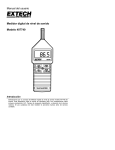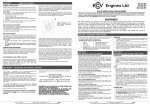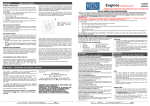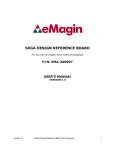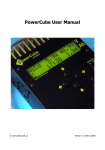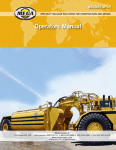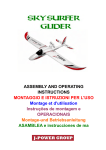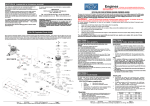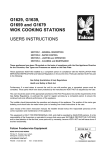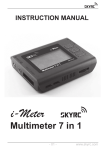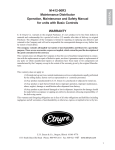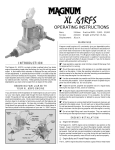Download Thank you for purchasing an RCV model engine. The RCV engine
Transcript
Thank you for purchasing an RCV model engine. The RCV engine operates on a unique mechanical principle that employs a one piece cylinder/valve which is driven around a conventional reciprocating piston and crankshaft assembly at half crank speed to facilitate a four stroke cycle of operation. The diagrams and photographs in this manual should clarify the elegant operating principle of your RCV engine. Following the very first proof of concept RCV, today’s production units have evolved into the current reliable and thoroughly practical range of model engines. Background The RCV Rotating Cylinder Valve engine is a unique concept enjoying world patents. In 1997 Keith Lawes, a keen aeromodeller and a Cambridge mathematics graduate invented the RCV engine and helped to form RCV Engines Ltd, the company. RCV continues to develop an increasingly diverse range of rotating cylinder valve engines, for the aeromodelling, aerospace and automotive industries. All RCV engines operate on the four-stroke principle. Due to the unique mechanical arrangement of the RCV concept, there is just one extra moving part over the far less efficient two-stroke engine, thereby facilitating a four stroke cycle of events. RCV’s unique rotating cylinder valve has eclipsed the need for the usual complicated four stroke valve train, whilst proving extremely durable and hard wearing. With beneficial cylinder wear and heat distribution properties over conventional engines and nothing to adjust, unlike a poppet valve system, your RCV engine is practically a maintenance free unit and with due care and consideration it will last you a modelling lifetime. A few “Do’s and Don’ts” As with any new engine, the temptation to try out your purchase immediately will be a strong one, but we strongly urge you to read this information (or the instruction manual included with the engine) before you attempt to start your new RCV. If your engine isn’t to be used to power a model in the foreseeable future you will need to carefully clean all fuel residues and oil liberally before you lay it up - Internal corrosion can result from bench running followed by a extended storage periods if the unit is not. If the engine is to be used in the near future, then just a few words of caution prior to starting your new engine. Use only our recommended fuel types and be sure to use a dedicated four-stroke glowplug. We only recommend the OS “F” type, having found it to be eminently suitable. Using the wrong fuel and plug will almost certainly result in an indifferent idle and slow running performance and in extreme cases could lead to engine damage. Lubricants Pure castor lubricants are not recommended because of their propensity to gumming and carbon deposition. Following extensive long term tests under a range of conditions we now recommend a synthetic / castor lubricant and a fully synthetic lubricant based fuel. We have enjoyed excellent results following extensive testing with Model Technics Duraglo & Weston Prosynth 2000. Alternative fuels we recommend are: Morgan Omega 10%, Wildcat Premium 10%, Byron Premium Sports 10%. Other fuels, however suitable, have not been evaluated by RCV so we cannot therefore guarantee their performance. d Photo User Guide Issue 1 – 2005 This is an additional support guide and should only be used in conjunction with the RCV user manual provided with the engine Nitromethane (Nitro) Fuel containing less than 10% nitro will produce indifferent idling and throttling performance even though peak power will not unduly suffer. Nitro, although generally regarded as a power enhancing additive is primarily used to improve flexibility and throttle response. Be wary of fuel manufacturers who quote liquor quantities by weight rather than volume. Nitro is a great deal heavier than methanol (or oil) and as a rough guide fuels quoting contents by weight will need a 15% Nitro mix! Using appreciably more than 10% Nitro (by volume) is not recommended as the increased cylinder pressures invoked may overstress your engine. Receiving your engine Your new RCV will arrive in a sturdy box, inside which will be a padded wrap containing the engine in its own polythene oily protective bag. Each engine is individually tested at our UK factory prior to dispatch. The muffler assembly is separately bagged, together with a pair of Allen keys for adjustment and servicing needs. The warranty and instruction sheets are also included. Be sure to read these thoroughly and register your warranty immediately. Receiving your engine CD engines arrive with their carburetors affixed to the manifold which will then require you to bolt this assembly to the engine casing. Use moderate pressure, employing the supplied Allen keys to affix this component. Do not be tempted to overtighten, and Do not forget the gasket CD Series Carburettor d Photo User Guide Issue 1 – 2005 This is an additional support guide and should only be used in conjunction with the RCV user manual provided with the engine There is a plastic plug sealing the inlet nipple and this, together with the breather nipple on the crankcase on the CD models, will need removing before use. These covers are a protective measure only for storage purposes Remove the black plug- this is for storage only Initial starting and running in Starting your new RCV for the first time should be an enjoyable and trouble free experience providing you adopt a methodical and workmanlike approach. The engine should be firmly mounted in a safe environment. The SP models drive huge propellers and must be mounted accordingly due to the torque reaction from an 18 –20 inch coarse pitched propeller, which is considerable. Do not run your engine in an enclosed space such as a your workshop or the garden shed due to the very real risk of carbon monoxide poisoning. Do ensure that all clothing is secure and that rags and the like are not casually left on the bench. Anything that can get caught in the propeller will in all likelihood be ingested with potentially dangerous results. Ensure that there is plenty of room to walk around your engine whilst running it so that you remain out of harms reach at all times. Never stand in front or to the side of the propeller whilst an engine is running. In the eventuality of a thrown propeller or part thereof, your only place of safety is behind the propeller arc. Tachometer measurements should always be taken from the rear and we advocate that you stop the engine to make fine carburetor adjustments for your own safety. Propeller selection Whilst your eventual propeller selection will depend on the model that the engine is used in, for initial running in purposes and general handling familiarity we recommend the following propellers. RCV 58 CD – 12 x 6 RCV 91 CD – 14 x 6 RCV 60 SP – 16 x 12 RCV 90 SP – 18 x 12 RCV 120 SP – 18 x 12 or 20 x 12 We have extensively tested a wide variety and range of propeller types and sizes and the sizes indicated above represent a good general choice for engine familiarisation and general flying. In practice we have also enjoyed good results with APC’s 12.25 x 3.75 (dedicated fun fly) propeller on the 58CD in lightweight aerobatic models. APC’s 13 x 6 / 14 x 6 / 15 x 4 perform well on the 91 CD with the smaller diameters more suited to faster flying WWII fighter types and the like. d Photo User Guide Issue 1 – 2005 This is an additional support guide and should only be used in conjunction with the RCV user manual provided with the engine The SP models will disappoint if propellers with less than 10 inch are employed due to their geared outputs which halve the output RPM (whilst doubling the torque) over conventional model aero engines (ie half the RPM = twice the torque = twice the pitch required) We recommend APC propellers (& other glass composite props) finding these to be both efficient and quiet. RCV carry stocks of these in suitable sizes should you have difficulty obtaining the correct propeller from you local dealer. As an approximate guide, your SP should be fitted with propellers that rotate between 5000 and 6000 RPM whilst the 58 CD and the 91 CD run most efficiently between 9000 and 13000 RPM. Propellers should be employed that load the engines to these speeds. Three and four bladed propellers will need to be reduced in size by approximately one inch in either pitch or diameter per blade increase. One of the great benefits of the SP series engines is that they pull large scale like 3 & 4-bladed props. We have extensively tested the SP range on three and four bladed propellers and can supply suitable sizes or offer suggested fitments. 16x10 3-bladed prop on RCV60SP Wooden Props – RCV don’t recommend the use of wooden propellers as quality and weight can differ significantly. In generally wooden props are much lighter than glass composite propellers and so do not give the desired flywheel effect. This can result in increased vibration on the SP series engines. Saying this however, many of our customers have used wooden propellers successfully. Zinger Propellers seem to work well with our engines. Starting a the new engine New engines will be very tight and may on occasion prove reluctant to turn sufficiently briskly with some less powerful starters. New 15 and 20cc units will need a fairly powerful starter initially although once broken in, frictional resistance will be greatly reduced which makes starter performance less demanding. Ensure that your starter leads are sufficiently robust and that your battery is capable of delivering the amperage needed to turn the engine at a reasonable speed for starting. Corroded or very small battery connectors allied to long lightweight leads will almost certainly cause your engine to rotate too slowly to start. The SP series requires your starter to rotate clockwise, meaning that the leads will be reversed from convention due to their geared output shafts which reverses the direction of the drive. Finally, some power panels are rather less than capable of supplying sufficient current to maintain a good glow whilst driving a powerful starter simultaneously and for that reason we advocate a separate glow battery. Starting the SP engine from behind the prop d Photo User Guide Issue 1 – 2005 This is an additional support guide and should only be used in conjunction with the RCV user manual provided with the engine Behind the propeller starting is potentially the safest method for any model engine operation and with the SP range this is strongly advised. Study the photographs paying particular attention to the reversal of the battery leads on your starter. This is necessary due to the gearing which reverses the propeller direction on these models. If starting from behind the propeller, remember to reverse the leads!! Running In Running in your new RCV is simple if a few basic rules are followed. These are not RCV rules per se; but rather rules for running in any engine. 1 Ensure that your engine is securely mounted, having previously gone over every fixing on the unit and in particular the carburetor screws & muffler, ensuring that these are tight. Do not overtighten anything, but do ensure that nothing is about to drop off or loosen. Like any other production engineered product, human error may well throw up the odd fixing that hasn’t been fully tightened and checking before running is therefore a sensible precaution. 2 On the CD series do not open up the engine mounting holes. This can weaken the engine crankcase so is not recommended. 3 We strongly advocate familiarisation in a test stand environment, but should you decide to fit your engine directly into the model, this will suffice for the purpose of running in the CD series, providing that you run a few tanks of fuel through on the ground first. Break in times vary with most engines needing one to three hours of accumulated time before giving their best. The SP models tend to need more time than the CD models, particularly the 120 which has a lot of large components to bed in. During the run-in period vibration may be higher so it is best carried out on a test stand. 4 All RCV engines are run prior to dispatch, therefore carb settings will be pretty much set. Running your new engine for the first time should be executed in relatively short bursts – say 3 to 5 minutes with a measurable period of cooling between runs. Set the needle rich and run the engine initially on about half throttle which will allow things to bed in nicely. After half an hour of accumulated time run the engine for short full power bursts, but still on a slightly rich setting, gradually increasing the workload of the unit until it feels “snappy” and it will hold peak RPM without sagging. At this juncture you can attend to the low speed mixture setting. If adjustment is needed it should only require a ¼ turn either way. There is little point in trying to adjust this initially with a tight engine. d Photo User Guide Issue 1 – 2005 This is an additional support guide and should only be used in conjunction with the RCV user manual provided with the engine Adjusting the main needle Adjusting the idle needle Settings Your carburetor will in all likelihood be set very rich on the slow running or secondary needle as supplied from the factory as previously mentioned. This is intentional as it ensures that the engine will start, given that four strokes need to be relatively rich when compared with a two stroke counterpart. We suggest that you pay little heed to the secondary setting for the first 15 minutes of running as the newness of the engine will preclude accurate settings and it is far better to err on the rich side to begin with. The main needle valve setting will need to be somewhere between three quarters and one and a half turns open from fully closed but tank position and plumbing issues will affect this to a degree. The throttle must be fully open when this adjustment is checked. With the throttle barrel in the closed position the main needle will bottom out against the spraybar. Spraybar end All four stroke model glow engines need to be wet for cold starts. To affect a choke mechanism, simply place a finger over the inlet venturi with the throttle wide open. Turn the “choked” engine over a few times by hand until fuel is drawn into the carburetor. Close the throttle to about one third and turn the engine over a couple of times to check for flooding or hydraulic locking before energising the glowplug and starter. With sufficient richness and a good glow the result will be an immediate start. d Photo User Guide Issue 1 – 2005 This is an additional support guide and should only be used in conjunction with the RCV user manual provided with the engine Placing a finger over the exhaust outlet whilst spinning the engine on the starter will also choke the engine effectively if exhaust pressure feeds the tank system but be aware that this can lead to severe flooding if overdone. Silencers RCV four stroke engines are not unduly noisy but all are supplied with a small (typical) silencer. Silencers can vibrate loose and if your engine mounts are less than good, silencer damage can result from continued running with the resultant severe vibration. Almost all silencer woes can be attributed to poor engine mounts or insufficiently tightened exhaust systems to begin with. Exhaust systems should be rechecked and tightened with the engine at running temperature to reduce the chances of further loosening due to heat expansion. Periodic checking is of course a wise precaution. Exhaust Locking nuts should be retightened when hot Throttle linkages Throttle linkages should enjoy a direct straight run wherever feasible. Reliable throttle operation can only take place if the linkage is geometrically correct and slop or bind free. On typical ARTF installations, the supplied (usually) wire for the throttle linkage should be insulated with heat shrink tubing here to reduce the chances of radio interference (slight) from metal to metal contact. Insulation here d Photo User Guide Issue 1 – 2005 This is an additional support guide and should only be used in conjunction with the RCV user manual provided with the engine On Board Glow Systems On board glow systems are worthwhile for multi engine scale models where the ultimate in reliability is paramount. We have enjoyed successful results with the Telco glow driver which operates “intelligently” by supplying current to the plug on demand only. Telco on board glow system – Sub C cell will facilitate both starting and flying whilst a single AA cell is sufficient for flying only Trouble shooting If your engine refuses to fire then check your plug and particularly your glow battery - the plug element should be an orange colour when energised – rather than a dull red. Check the rotational direction of your starter. We have had many SP owners try to start their engines backwards with the starter rotating anti clockwise (ie the conventional direction) and it’s a common mistake! With a healthy bright orange glow allied to sufficient richness and with the throttle set to one third your RCV will start very quickly. All RCV engines are easy and quick starters and a logical and methodical approach will soon determine any reason for failure. Warranty claims Providing your RCV engine is operated in accordance with these instructions it is guaranteed against all manufacturing defects for a period of 2 years. RCV engines Ltd are UK based and we are available to answer technical or warranty enquiries by email or telephone. If your engine needs to be returned for any reason, please use the original packaging and documentation. Applications Customers have fitted the entire range of RCV engines to a very diverse selection of model types worldwide. Some of the more exotic or unusual models have been made known to us and our technical team, all keen aeromodellers, will be more than happy to offer advice and information should you have an unusual project in mind. Some extremely sophisticated competition winning scale models have benefited from the unique characteristics of their RCV engine(s). d Splendid scratch build Flying Flea powered by RCV58CD Photo User Guide Issue 1 – 2005 This is an additional support guide and should only be used in conjunction with the RCV user manual provided with the engine Hangar 9 ARTF Mustang – RCV 91CD powered – note how the compact nature of the CD facilitates a fully cowled engine FAQ How powerful is my RCV engine? Whilst our engines are not as powerful as out and out competition types, having been engineered for reliability and longevity, they all perform willingly and enjoy excellent handling characteristics. Testing has show them to perform similarly to other sports four strokes of similar capacity, with the very real RCV advantages of low maintenance and reduced physical dimensions. RCV91CD is the same physical height as a typical 48/52 conventional 4-stroke What is the fuel consumption of an RCV engine? The whole range is remarkably frugal. In practice an 8oz tank will prove sufficient for the 58 and 60 SP increasing pro-rata for the 90/91 up to the 120 SP where a 16 to 20 oz tank should prove adequate for most applications. 16 oz tank in Hangar 9 Mustang gives more than adequate duration for its RCV 91 CD d Photo User Guide Issue 1 – 2005 This is an additional support guide and should only be used in conjunction with the RCV user manual provided with the engine Mounting your engine The SP range produce huge torque and drives very large diameter propellers and for this reason these models must be very well mounted. We supply a dedicated back plate mount designed to spread the load of the mounting points to prevent the firewall of your model crushing. You should always use this when mounting your SP and pay particular attention to the suitability of the structure of the model in the appropriate areas. If you are looking at using the engine in more than one model you can purchase additional backplates from RCV RCV SP series backing plate Cowling your RCV Cowling any RCV engine is easily achieved due to the very compact nature of the design. Be very aware that your RCV, like any other IC aero engine, must be adequately catered for in the cooling department. Because of the reduced physical dimensions over other engines of similar power and displacement, this can be overlooked. The examples shown here give an indication of good practice. Full sized aero engine installations may look as though they have relatively small entry and efflux ports but upon closer inspection cowls are ducted to direct air directly over the cooling fins and you should replicate that situation too. Mustang cowl has additional outlets for cooling air – as a general rule outlets should be three times the area of inlet holes 3D from Modeltech is powered by RCV 91 CD – cowl inlet has been carefully shaped to force air over the cylinder head – cowl bottom has been drilled and relieved to ensure that it can escape again d Photo User Guide Issue 1 – 2005 This is an additional support guide and should only be used in conjunction with the RCV user manual provided with the engine Ultimate powered by RCV 60 SP – cowl ducts air directly towards engine fins How do I maintain my RCV and keep it in tip top condition We strongly recommend that you run the engine dry after use to remove all unburned fuel residue as this is extremely corrosive. Methanol is Hygroscopic, meaning that it retains water and moisture retention will invoke rust and general corrosion problems. Disconnect the fuel feed from the carburetor and restart the engine, repeating the operation until the engine refuses to fire any longer before storage. Never leave raw fuel in your engine and where possible, always disconnect the fuel feed from carburetor after use. A small piece of oily rag or tissue used to block inlet and exhaust orifices will help to prevent moisture ingress during storage. Finally, store your model nose UP. This prevents fuel and exhaust residue running back into the stored engine, minimising problems. Keep your engines clean and dust free and treat your RCV as the precision miniature engineering device that it is, both during use and in storage. Crash damage We at RCV appreciate only too well that model aeroplanes crash from time to time. The engine is invariably the first point of contact with terra firma and damage can be almost inevitable following and accident. If the engine looks damaged in any way at all then resist the temptation to rotate it to check for bent or broken parts as this may exacerbate things. Dirt or mud should be washed off using a toothbrush under a running tap followed by a liberal spray with a WD fluid. Closer inspection will reveal how serious the damage is and should you suspect a bent crankshaft or displaced bearings or worse then remove the engine from the (remains of…) the model, spray with a proprietary WD protection fluid and return the unit to RCV for a repair quotation. d Photo User Guide Issue 1 – 2005 This is an additional support guide and should only be used in conjunction with the RCV user manual provided with the engine For those that feel confident enough to undertake maintenance or repair work themselves, the following information will prove useful. Be aware that whilst both SP and CD types are simple to dismantle, there are one or two parts that may get lost during disassembly, such as Woodruff keys and in particular the PTFE pad that locates on one end of the gudgeon pin. When putting your engine back together it is essential of course that the cylinder valve is correctly timed. As from 1st August 2005, if you return your warranty form within 1 month of purchase, you will automatically benefit from our lifetime repair offer. Therefore even if you crash your engine, you will never have to pay more than 50% of the cost of a new engine (RCV RRP) to cover repair or replacement. Reassembling and timing the RCV Timing the Cylinder (on all engines) The rotating cylinder on all RCV engines has to be timed with crankshaft rotation. RCV assembly and timing is infinitely more simple than similar work on conventional poppet valved four stroke engines and with care, is foolproof. The correct timing placement of the cylinder valve assembly will be effected when the cylinder port is equidistant between the inlet and exhaust orifices in the casing. with cylinder correctly held in position in its casing, carefully engage the gear to the crankshaft with piston at TDC This can be achieved visually by holding the unit up to a window or light and peering intently through the ports but for absolute certainty a very small plastic tie wrap passed through the inlet and exhaust will lock the cylinder in place in its housing. Carefully bring the piston to top dead centre by rotating the crank assembly ensuring that the small PTFE pad remains in situ on one end of the gudgeon pin before gently lowering the cylinder over the piston as you gently compress the ring. The piston ring is free to rotate meaning that orientation of that component is non critical, but it is essential that the crankshaft remains stationary during this operation until the gears are meshed d Photo User Guide Issue 1 – 2005 This is an additional support guide and should only be used in conjunction with the RCV user manual provided with the engine SP models can be assembled with the two halves of the engine in one of four orientations, making scale model installation very flexible. As long as the rotating cylinder is correctly timed to the crankshaft, all will be well. Changing the orientation of the outer cylinder will NOT reverse the rotational direction of the engine (a common misperception). Changing the Orientation of the outer cylinder Storage Models not in use should be have ALL traces of fuel removed from the engine (ie start and run DRY) before being hung from a suitable hook nose UP. Storing your model nose UP is very beneficial because it ensures that no nasty corrosive exhaust by products run back into the engine during the lay up period. Storing nose UP also ensures that should you be less than vigilant with the aforementioned, at the very least these corrosive elements will rest on the backplate of the unit, rather than in the bearings, thereby minimizing the risks of corrosion damage. Suitable lay up oils are now commercially available expressly for the purpose allied to which blocking the inlet and exhaust orifices with an oily tissue will help things stay in fine fettle. Store your models in a dry area which should ideally be free from dust and cold damp air. If this isn’t feasible and you really do have to resort to the rafters in your unheated garage then removing the engine for prolonged storage is advocated. Corrosion damage can be terminal and more engines are ruined this way any. d Photo User Guide Issue 1 – 2005 This is an additional support guide and should only be used in conjunction with the RCV user manual provided with the engine













